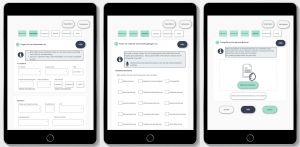Development and usability evaluation of a prototypical structured digital self-assessment of patient anamnesis service for the elderly
Aim and Research Question(s)
The aim of this thesis was to develop and evaluate a user-friendly clickable first-level prototype especially for older people to collect medical data.
- RQ1: What functional and non-functional requirements are necessary for a structured digital self-assessment of patient anamnesis used by older patients before the first doctor’s appointment?
- RQ2: Does the first-level prototype prove to be usable also for older people in the context of a first explorative pilot study?
Background
A detailed anamnesis (patients’ medical history and symptoms) is an essential requirement for a correct diagnosis and optimal treatment [1, 2]. In most medical practices the anamnesis is taken during the first doctor-patient conversation [3], although the use of structured questionnaires leads to obtaining a more detailed patient’s anamnesis compared to conducting a doctor’s consultation on its own [4, 5]. In the last years digital solutions to collect the anamnesis were developed and patients overall provide positive feedback on them, but different studies report that older people or those with less affinity for technology overall have difficulties and need support [3, 6–8].
Methods
An adopted user-centred design approach was chosen:
- Understanding and specifying the user context: literature and market research
- Personas were created and requirements defined
- Design of first paper-pencil mock-ups and development of prototype with Axure
- Evaluation: usability test including questionnaires, thinking aloud, task-completion rate and time on-task
Results and Discussion
The result is a tablet-based prototype with the functions to fill in core data, answer medical questions, upload medical reports and sign data protection agreements digitally. For the development eight functional and eight non-functional requirements were being considered including a list of 41 accessibility design-recommendations for design of mobile technologies used by the elderly.
Five participants (older than 60 years) rated the usability of the prototype with the System Usability Scale (SUS), resulting in a SUS score of 79, which can be considered as good. All people could successfully complete every task. People with very little or no technology experiences revealed uncertainties at the beginning of the user test, because they needed to get to know basic functions of entering data digitally. They showed that the functions are intuitive and can be learned while using the prototype.
Conclusion
In a next step, the improvement possibilities identified during the usability tests should be implemented and then the prototype should be tested again. For further development, a function to share the collected data with different doctors could be considered.
References
[1] Kassirer J. P. (2014). [2] Moonen P. J., Mercelina L., Boer W. & Fret T. (2017). [3] Kopp M. et al. (2021). [4] Bachman J. W. (2003). [5] Renggli J. F. et al. (2020). [6] Hess R., Santucci A., McTigue K., Fischer G., & Kapoor W. (2008). [7] Melms L., Schaefer J. R., Jerrentrup A., & Mueller T. (2021). [8] Wong D. et al. (2017).